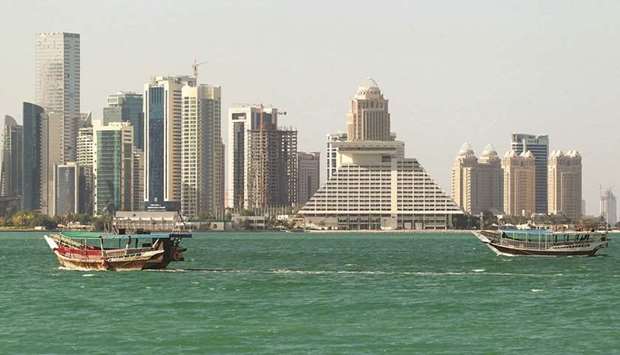Global credit rating agency Capital Intelligence (CI) has affirmed Qatar's long-term foreign currency rating (LT FCR) and long-term local currency rating (LT LCR) at ‘AA-’.
The sovereign’s short-term foreign currency rating (ST FCR) and short-term local currency rating (ST LCR) have been affirmed at ‘A1+’. The outlook for the ratings remains "stable".
The ratings are supported by the substantial government assets under the management of the sovereign wealth fund, the Qatar Investment Authority (QIA); very large hydrocarbon reserves; a high degree of expenditure flexibility; and low domestic political risk.
The rating agency regards Qatar’s external and public finances as strong due to the government’s substantial external assets which have been accumulated over the past two decades.
During 2000-20, Qatar’s average budgetary surplus amounted to 9% of GDP (gross domestic product), a large part of which has been invested in external assets.
"As a result, the QIA’s total assets are estimated to be in the region of $300bn, or 205% of GDP in 2020," it said.
Although an assessment of the QIA’s quality of assets is complicated, CI considers the very large overall size of the fund to be an important rating strength.
Qatar’s fiscal and external position has benefited from the rebound of hydrocarbon prices over the past months, it said, adding in view of the latter, the rating agency now forecasts the current account to register a surplus of 4.7% of GDP in 2021 compared to a deficit of 2.5% in 2020.
Meanwhile, the budget surplus is forecast to rise to 5.2% of GDP in 2021, from 1.3% in 2020.
While the reliance on hydrocarbon revenues renders the public finances vulnerable to hydrocarbon price shocks, the government has "ample leeway" to respond to such shocks due to the high degree of expenditure flexibility, the report said.
The rating agency has found that a large share of sovereign expenditure falls upon discretionary spending items as public investment, and the relative size of the public wage bill is much smaller than in more populous GCC, or Gulf Co-operation Council, countries.
In this regard, CI notes that Qatar is the only GCC country which registered a budget surplus in 2020 as the shortfall in hydrocarbon revenues was partially offset by large cuts in public spending (primarily investment spending).
While the government has registered budgetary surpluses over the past years, gross government debt has increased due to several large international bond issues.
It reached a moderate-to-high 71.6% of GDP in 2020, from 62.3% in 2019, on the back of a $10bn international bond issue in April 2020 alongside a sharp contraction in nominal GDP.
"Going forward, CI’s baseline scenario anticipates debt dynamics to reverse and forecasts a decrease in government debt to 52.2% of GDP in 2022 as we expect budget surpluses to increase and the size of international bond issuances to decrease," it said.
The sovereign’s short-term foreign currency rating (ST FCR) and short-term local currency rating (ST LCR) have been affirmed at ‘A1+’. The outlook for the ratings remains "stable".
The ratings are supported by the substantial government assets under the management of the sovereign wealth fund, the Qatar Investment Authority (QIA); very large hydrocarbon reserves; a high degree of expenditure flexibility; and low domestic political risk.
The rating agency regards Qatar’s external and public finances as strong due to the government’s substantial external assets which have been accumulated over the past two decades.
During 2000-20, Qatar’s average budgetary surplus amounted to 9% of GDP (gross domestic product), a large part of which has been invested in external assets.
"As a result, the QIA’s total assets are estimated to be in the region of $300bn, or 205% of GDP in 2020," it said.
Although an assessment of the QIA’s quality of assets is complicated, CI considers the very large overall size of the fund to be an important rating strength.
Qatar’s fiscal and external position has benefited from the rebound of hydrocarbon prices over the past months, it said, adding in view of the latter, the rating agency now forecasts the current account to register a surplus of 4.7% of GDP in 2021 compared to a deficit of 2.5% in 2020.
Meanwhile, the budget surplus is forecast to rise to 5.2% of GDP in 2021, from 1.3% in 2020.
While the reliance on hydrocarbon revenues renders the public finances vulnerable to hydrocarbon price shocks, the government has "ample leeway" to respond to such shocks due to the high degree of expenditure flexibility, the report said.
The rating agency has found that a large share of sovereign expenditure falls upon discretionary spending items as public investment, and the relative size of the public wage bill is much smaller than in more populous GCC, or Gulf Co-operation Council, countries.
In this regard, CI notes that Qatar is the only GCC country which registered a budget surplus in 2020 as the shortfall in hydrocarbon revenues was partially offset by large cuts in public spending (primarily investment spending).
While the government has registered budgetary surpluses over the past years, gross government debt has increased due to several large international bond issues.
It reached a moderate-to-high 71.6% of GDP in 2020, from 62.3% in 2019, on the back of a $10bn international bond issue in April 2020 alongside a sharp contraction in nominal GDP.
"Going forward, CI’s baseline scenario anticipates debt dynamics to reverse and forecasts a decrease in government debt to 52.2% of GDP in 2022 as we expect budget surpluses to increase and the size of international bond issuances to decrease," it said.




